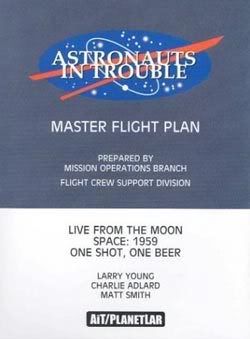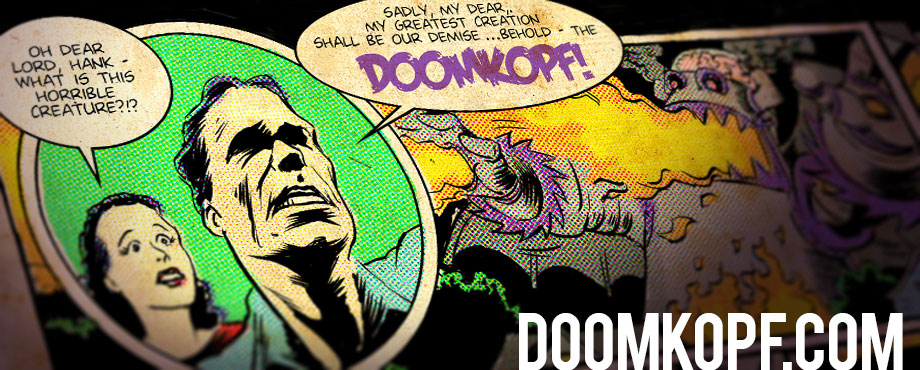Astronauts in Trouble: Master Flight Plan
 By Larry Young (W), Charlie Adlard and Matt Smith (A)
By Larry Young (W), Charlie Adlard and Matt Smith (A)
Published by AiT / PlanetLar. Cover price $19.99. Originally published as Astronauts in Trouble: Live from the Moon #1-5; Astronauts in Trouble: Cool Ed’s #1; Astronauts in Trouble: Space 1959 #1-3; Astronauts in Trouble: One Shot, One Beer
Astronauts in Trouble is one of those high-concept pieces, sort of like Snakes on a Plane, where the title seems to give a pretty strong hint of what you’re getting into. But more than just astronauts in trouble, the three main stories that make up this hardcover compilation tie together two of the most fascinating evolutions of the latter half of the 20th century: space travel and the media.
Live from the Moon follows the fearless Channel 7 news team as they find themselves passengers on an unexpected trip to the moon, where a multi-billionaire entrepreneur – the modern-day mad scientist super-villain – has essentially declared the earth’s natural satellite his personal playground. He got there first, and he paid for the work. How American!
Space 1959 jumps back in time to the early days of the space race, following an early incarnation of the Channel 7 news team on a collision course between fierce patriotism and freedom of the press.
And One Shot, One Beer uses the setting of a far-future moon bar and patron conversations to tie together the characters we met in the two previous stories. Closing out the book are a handful of 2-page backup stories that Young used to help draw in readers to the first AiT series.
So much of what is written about AiT deals with the middle-aged man’s fascination with his childhood observation of the moon landing and how that sparked his imagination. Being far too young to have witnessed that (I wanted to be an astronaut as a kid until I learned that ET wasn’t real), I can safely say you didn’t have to witness any particular small steps or giant leaps to enjoy these stories.
The Art:
AiT is in black and white, and all of the artists involved in the various projects did an amazing job handling the two-tone storytelling. Charlie Adlard, perhaps best known these days for his work on Robert Kirkman’s Walking Dead, handles most of the art chores, while Matt Smith illustrated the first few issues of Live from the Moon. Prior to these stories, I was unfamiliar with Smith’s work, but I enjoyed it quite a bit, even when held up to Adlard’s illustrations.
The best way I can think to describe Smith’s art is that it’s somewhere between the abstract angularity of Mike Mignola while working in more detail and expressions in a manner reminiscent of Kevin Nowlan. The drawback to Smith’s art – in comparison to Adlard’s on these issues – is that it’s a little harder to tell some characters apart. And Adlard does some fantastic work, including an absolutely iconic page in 1959 where the Colonel rushes to save the day.
The two-page backup stories include some great work by the likes of Kieron Dwyer and some Darick Robertson illustrations that look strangely like Art Adams drew his monkeys (I’ve never seen him try to pull that off before).
The Writing:
It’s only at the very end of this book that anything is tied together. Prior to that, these are unrelated slices into worlds we know nothing about, other than how they may relate to our own. Reading these stories is like a vivid dream, where you step inside a world that has its own history built in, but you only get to experience at the pace it presents itself.
Larry Young wastes absolutely no time with unnecessary exposition, which is simultaneously a strength and weakness of the story. Each tale introduces us to characters we’ve never met, and it takes a while to get a handle on who is who. It’s rare that you read a comic with so little in the manner of character introductions. But once you get past that, it ends up working brilliantly in presenting these tales as little windows into a world moving so quickly that it has no time for the convenience of exposition. This is especially evident in the 2-page backup stories, which almost flaunt their lack of context with infectious success.
The stories also manage to be everything you’d want a great comic story to be – action, adventure, commentary, insight. You get the hint that Young had a “What I’d love a great story to include” fantasy list before he put pen to paper, but it works without coming off the least bit self-indulgent.
The Good:
These are fun stories. There’s really no more descriptive way to put it. Personalities clash, crazy things happen, and even when things don’t turn out so well, there’s still a level of excitement to it all that makes you want to keep reading. I would love for Young to just keep cranking out more stand-alone glimpses into the AiT world.
The Bad:
The quick introductions to numerous characters with by-default less-descriptive black and white art can make the first few pages of each story a little confusing, but nothing that doesn’t sort itself out soon enough (or that a quick re-read wouldn’t help). It helps to go into these stories realizing that they don’t overlap, otherwise a less-informed reader (not to name any names) might notice similar facial hair or similar uptight lead reporters and think a connection is supposed to exist where it doesn’t.
Overall:
A. I loved this book. So many comics commentators seem to mask superhero shame when they say “Comics don’t have to be about muscle-men in spandex to be good.” Well if you’re afraid picking up a non-superhero book means you’re selling out and turning emo, don’t worry. This book will satisfy both camps – it’s smart and relevant, and it’s tons of fun.

I can’t believe I’ve never read this.